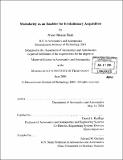Modularity as an enabler for evolutionary acquisition
Author(s)
Shah, Nirav Bharat, 1979-
DownloadFull printable version (6.847Mb)
Other Contributors
Massachusetts Institute of Technology. Dept. of Aeronautics and Astronautics.
Advisor
Daniel E. Hastings.
Terms of use
Metadata
Show full item recordAbstract
The end of the cold war witnessed several significant changes in the defense acquisition environment. Budgets declined and the scope of mission expanded. At first, the DoD did not respond well to these pressures resulting in cost overruns and schedule delays becoming the norm. In an effort to change this situation, national security officials decided to fundamentally change the way systems were acquired, shifting the focus to systems that could evolve/adapt to changing resources and needs. To operationalize this shift they recommended implementing an evolutionary acquisition strategy using a spiral development process. The fundamental characteristic of the evolutionary acquisition strategy is a focus on delivering a minimum capability early and then building upon that capability as risks are resolved. This imposes requirements on the acquisition process and the system architecture. From a process perspective, since needs and resources are changing involving all relevant stakeholders is key to successful evolutionary acquisition. Since the objective was to prevent cost overruns and schedule slips, understanding and mitigating key risks is central to success. From an architectural perspective, the ability to update the system to allow for enhanced capability is important. The MATE-CON process can be used to satisfy the process related requirements of evolutionary acquisition. MATE-CON uses a multi-attribute utility theory to capture the diverse and changing needs of decision makers. Then tradespace exploration is used fully reveal the impact of design decision on decision maker perceived value. By representing both value and expense in terms of metrics that all stakeholders can understand, MATE-CON facilitates effective collaboration between stakeholders. (cont.) A modular architecture provides the architectural flexibility required when using evolutionary acquisition. By separating system components into a few decoupled modules, the modular architecture allows enhancements to be made to the modules without adversely affecting the rest of the system. Changes can be made to accommodate new needs or incorporate new capabilities. This flexibility in-service come at the price of a possible loss of performance and/or design efficiency. Thus valuation of the flexibility gained is crucial. An options framework that incorporates risk identified by the stakeholders should be used. The Space Based Radar is good a example of a system that demonstrates that challenges faced by defense acquisition identified above. The most recent attempt at an actual hardware demonstration was canceled because of cost overruns and schedule slip. Using the MATE-CON approach and a modular constellation architecture, evolutionary strategies for space-based radar can be found.
Description
Thesis (S.M.)--Massachusetts Institute of Technology, Dept. of Aeronautics and Astronautics, 2004. Includes bibliographical references (p. 111-112).
Date issued
2004Department
Massachusetts Institute of Technology. Department of Aeronautics and AstronauticsPublisher
Massachusetts Institute of Technology
Keywords
Aeronautics and Astronautics.